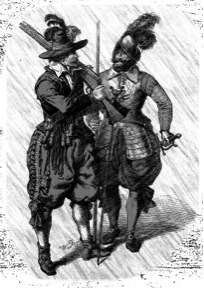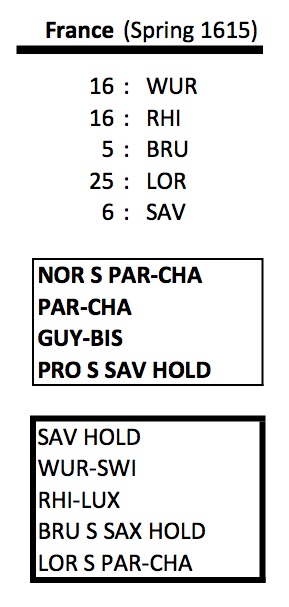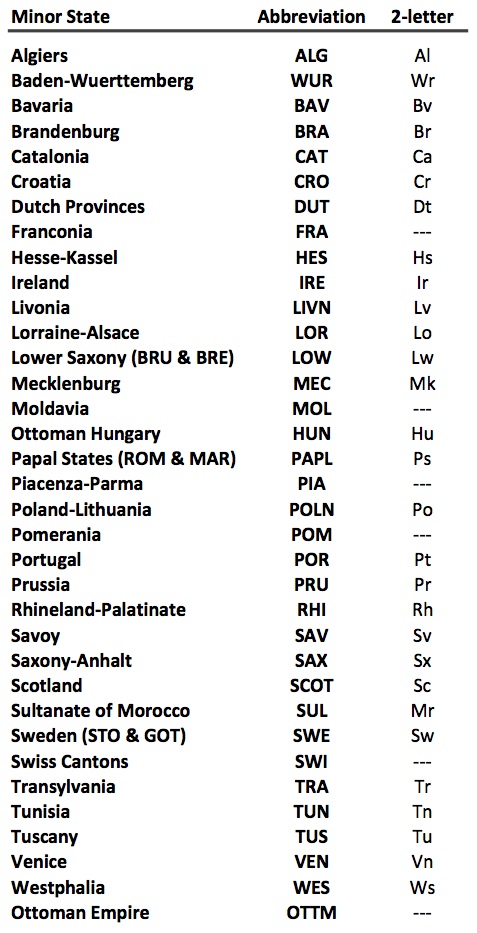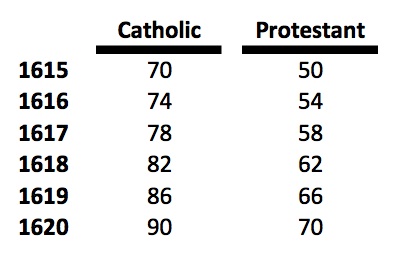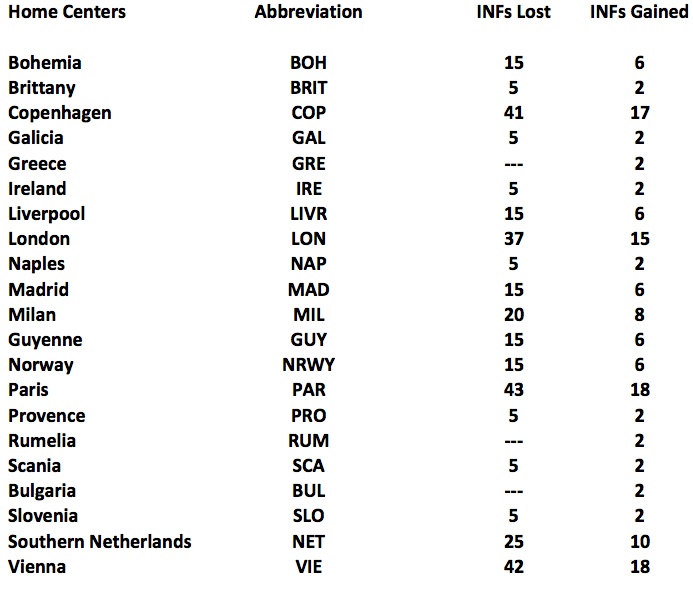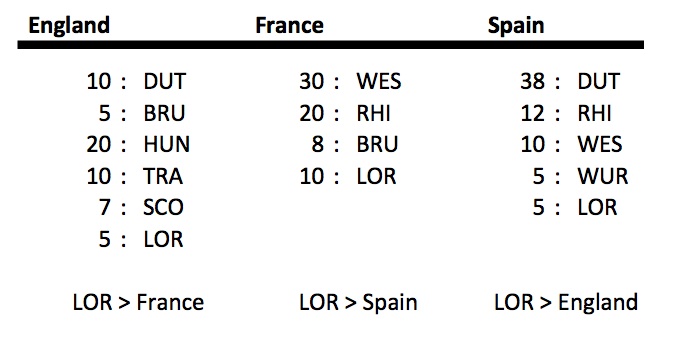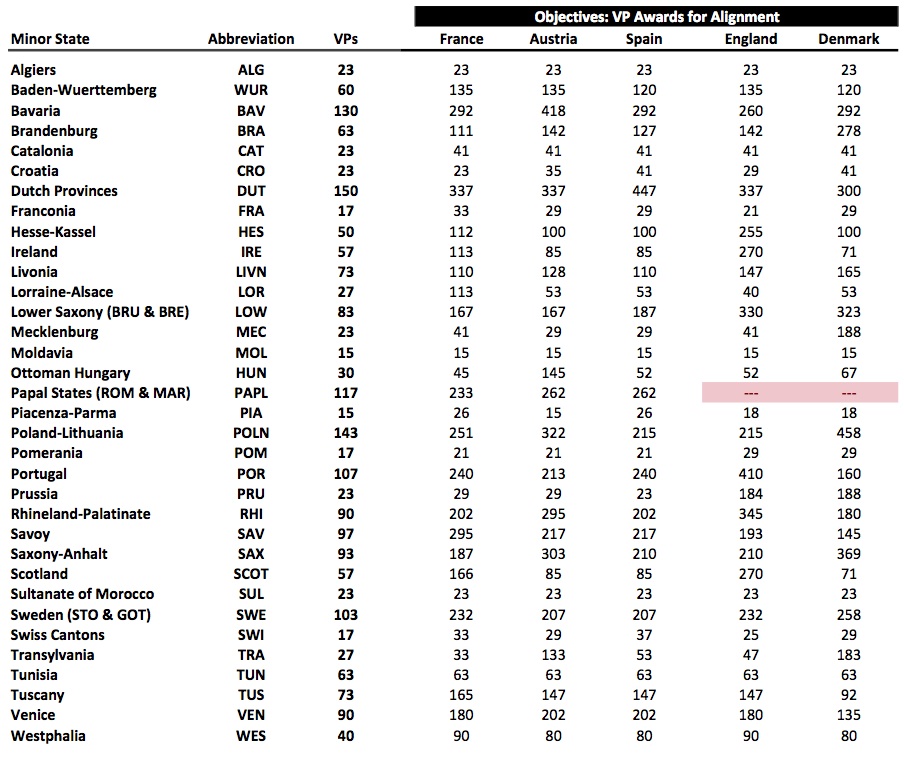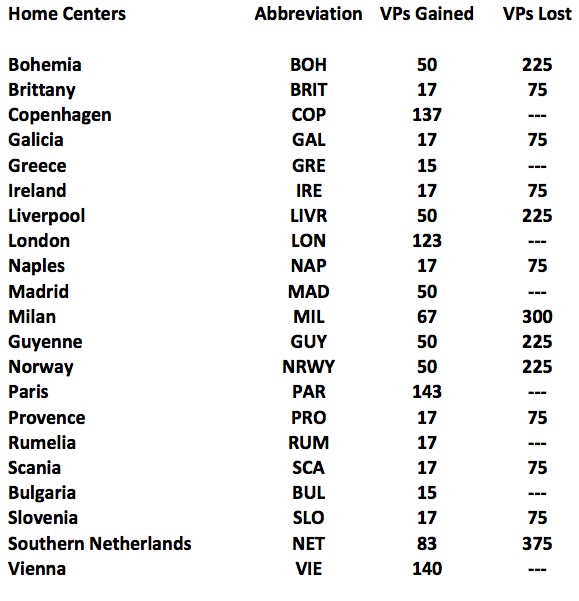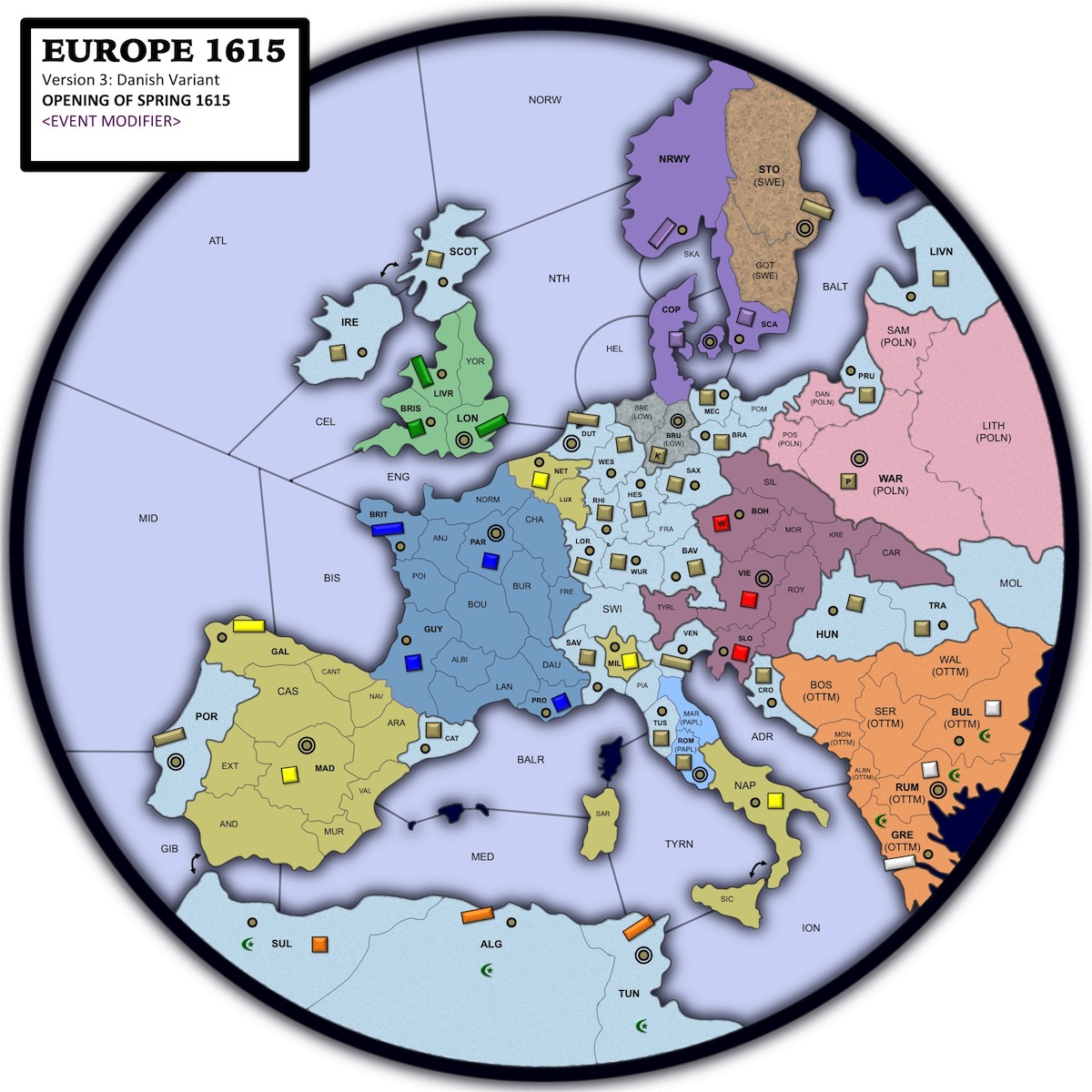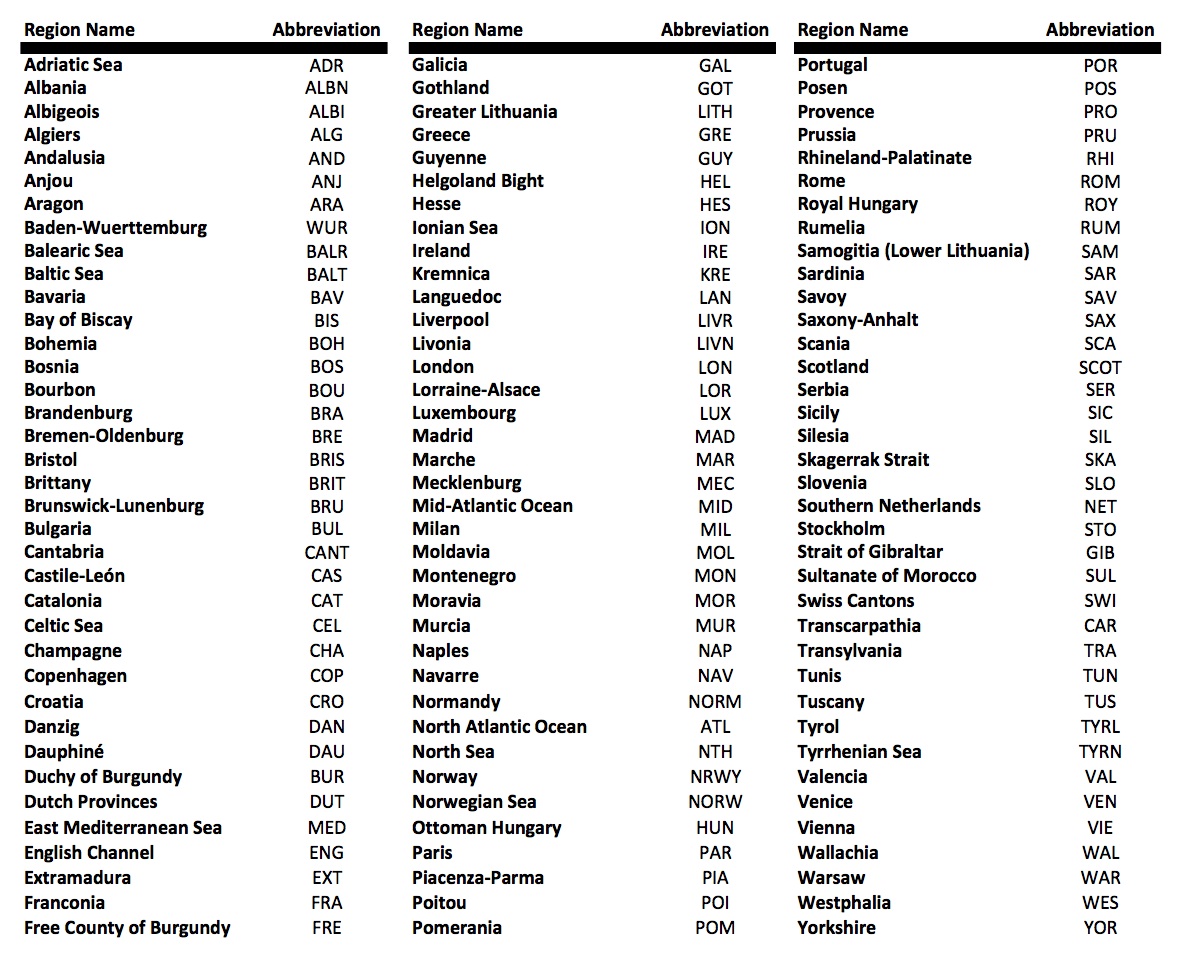Difference between revisions of "Europe 1615: Version 3"
(New page: Image:soldiers.jpg '''EUROPE 1615: VERSION 3’’’ A DIPLOMACY VARIANT by Matthew Medeiros [Play-testers needed! Currently recruiting players at www.diplomaticcorp.com under...) |
|||
| Line 222: | Line 222: | ||
| − | + | '''Scoring from Religious Markers''' | |
| − | At the scoring phase, Protestant | + | At the scoring phase, each Protestant power receive 50 VPs for each Protestant marker on the board. This rule also applies to Catholic powers and Catholic markers. |
| − | + | '''Scoring Penalties''' | |
A power that lose a home supply center will suffer a penalty for each year without the home center. | A power that lose a home supply center will suffer a penalty for each year without the home center. | ||
Revision as of 00:46, 22 February 2014
EUROPE 1615: VERSION 3’’’
A DIPLOMACY VARIANT
by Matthew Medeiros
[Play-testers needed! Currently recruiting players at www.diplomaticcorp.com under Open Games (select Games > Open Games in the main menu). Any comments or questions please write to medeiros412@aim.com. Thank you.]
INTRODUCTION
The Europe 1615 Diplomacy variant allows players to take the reins of one of the great powers of the time: Austria, France, Spain, England, and Denmark. During the game, players deploy influence points (INFs) and orders to secure political and/or religious authority over the minor states and their units. The Ottoman Empire can be influenced as well, and may be controlled anonymously by any one of the players. Victory is measured by the gain of victory points (VPs) through various aspects of the game (military conquests and political/religious objectives). Game begins in 1615 and runs up until the end of 1620.
Standard 5th Edition rules of Diplomacy apply with modifications as described below.
PHASES OF THE GAME YEAR
1- Initial Status Check
2- Spring Movement and Retreat Phase
3- Summer Movement and Retreat Phase
4- Fall Movement and Retreat Phase
5- Early Winter Adjustment Phase
6- Period Modifier Announced & Late Winter Adjustment Phase (Build Phase)
7- Scoring Phase
GAME MODIFIER (OR PERIOD MODIFIER)
Probability for a given event based on roll of 3 six-sided dice:
DEPLOYMENT OF INFLUENCE POINTS WITH SUBMISSION OF ORDERS
Each power receives influence points (INFs) at the beginning of each year to distribute to the minor states with (or without) orders.
INFs Available per Year
Writing the orders: Example of the format for the submission of the INF deployment list and orders is as follows:
In the above example, France deploys all INFs in the first phase as follows: 16 INFs to Wurtemburg (WUR), 16 INFs to the Rhineland (RHI), 5 INFs to Brunswick (BRU), 25 INFs to the Lorraine (LOR), and 6 INFs to Savoy (SAV). In addition to submitting orders for French units (shown in thin-bordered box), France submits orders to the units in the minor states where the INFs will be deployed to (heavy-bordered box). Additionally, INFs may be deployed to minor states without a SC/unit such as, for example, Franconia (FRA). Powers need not deploy all INFs in the first phase, but can spread out those deployments in subsequent phases. INFs will continue to accumulate in the minor states with each deployment dictating the status of state. Any unused INFs do not carry forward into the next year, and players cannot deploy more than the available INFs for the year.
A listing of the minor states that may be influenced is given below.
TABLE 1: List of Pliant Minor States
Note: The Catholic powers, only, may deploy INFs & submit orders to the Papal States (PAPL) which consist of Rome (ROM) and the Marche (MAR). Poland-Lithuania (POLN) consists of the provinces of Lithuania (LITH), Samogitia (SAM), Warsaw (WAR), Danzig (DAN) and Posen (POS), therefore, their statuses will match POLN. Two-letter designations for each minor state are given to label the armies/fleets on the board.
Influencing the Ottoman Empire
The Ottoman Empire (OTTM) is treated much like the pliant minor states, however, the Empire spans over several provinces and has 3 units in its military service: A(RUM), F(GRE), and A(BUL). As a whole, INFs may be deployed to the Ottoman Empire with corresponding orders. The GM keeps the deployment of INFs to the Ottoman Empire secret, and only reveals the actions of the units in the adjudication (or whether the Ottoman Empire is neutral).
EFFECTS OF INFLUENCE AND RULES GOVERNING THE STATUSES AND ACTIONS OF THE MINOR STATES
Status of the Minor States
The minor state is marked as ALIGNED, NEUTRAL or UNMARKED depending on how the major powers invest INFs in the minor state. Minor states marked as ALIGNED are in allegiance with the major power holding the most influence (50% or more of the total INFs deployed to the state) and will follow the orders submitted by the power. For two or more powers equally invested in a minor state, the minor state will be marked as NEUTRAL and the orders submitted to those states will be ignored.
Minimum # of INFs for an alignment:
Minor States = 5 INFs
Ottoman Empire = 25 INFs
Explanation: The political status of the minor state is ALIGNED if a single major power holds 50% or more of the total INFs present in the minor state and has minimally 5 INFs invested. Orders submitted by the power to any aligned state will be followed by the unit of the state (where ever it is on the board) and reported in the adjudication. The allegiance of the Ottoman Empire, in 1615, requires that a major power holds 50% or more of the total INFs present and minimally 25 INFs invested. The GM keeps the aligned major power for the Ottoman Empire secret. Political status of a minor state is not established if there are less than 5 INFs present. Minor state is then considered UNMARKED. (If there are less than 25 INFs in the Ottoman Empire, its status will default to NEUTRAL.) After submission of orders and INF deployment, the GM publishes the results, which powers have deployed to which states and whether the orders submitted are followed or not, but does not reveal the actual number of INFs deployed by each power; instead, the percentage of INFs held is published.
Rules Concerning Political Status of Minor States
GM evaluates the INF deployment lists of each power, the accumulation of INFs in each minor state, and then determines their statuses. This is published with the adjudication. In resolving the orders, the GM considers the following:
(1) If the political status is not established (UNMARKED), any major power may move into and/or capture the minor state. Any power can support the hold of a minor state's unit whether the minor state is aligned or unmarked.
(2) If the political status is NEUTRAL, no major power can enter the minor state as it violates the neutrality status. Neutral units within neutral states cannot receive support (however, a support, move, or convoy order may be submitted to the unit of a neutral minor state in anticipation of a change in status).
(3) If the political status is ALIGNED, the unit of that minor state will follow the HOLD, SUPPORT, MOVE/ATTACK, or CONVOY order submitted by the major power that holds the majority of INFs in the minor state (if no order is submitted the unit holds by default). The major power cannot dislodge or support the dislodgment of the aligned minor state's unit, even if that dislodgment is unexpected. Additionally, the major power may SUPPORT the unit's HOLD or MOVE (other powers may SUPPORT the unit as well). If no unit is present in an ALIGNED minor state, any major power may enter the state freely. For a power aligned with the Ottoman Empire, the GM keeps the player/power anonymous, but orders are published in the adjudication. Communications with the Ottoman Empire should be conducted by public white/grey press or through the GM. Major power aligned with the Ottoman Empire is responsible for ordering retreats and builds.
Religious Status of the Minor States
The combined INFs remaining for England and Denmark represent the influence of the Protestant factions in the state. The combined INFs of Austria, France and Spain represent the influence of the Catholic factions in the state. The religious status of the minor state is MAJORITY if a single religious faction holds the minimally required percentage of the total INFs present for the given year, and has minimally 10 INFs invested (see table below). If the condition above is not met then the state is marked as religiously NEUTRAL. Protestant or Catholic majority is marked on the map throughout the game and becomes important during the scoring phases. Papal States will always be marked as a Catholic majority. Religious status for the Ottoman Empire and the Barbary States do not change. They are, for the purposes of this game, permanent Islamic states.
Percent Requirement by Year for the Religious Control of a State:
In evaluating Protestant or Catholic majority in a minor state, first determine which faction holds the majority of INFs in the state, has the required minimum of 10 INFs, and then determine whether the required percentage is met based on the table above; otherwise the religious status is marked as neutral. Example: Saxony has 60% INFs held by the Protestants, and 40% held by the Catholics in 1618. Although the Protestants have the majority they do not meet the required 62% and thus the state is marked religiously neutral.
Additional Rules Concerning the Minor State and Its Army/Fleet
Capturing a SC: Any minor state's army can capture a supply center and contribute to its expansion.
Disbanding: If the supply center of a minor state is captured when the state's army is positioned elsewhere on the board, the army is disbanded at the Early Winter Adjusment Phase. If the minor state's army is dislodged, it is then disbanded (no retreats allowed). However, units of the Ottoman Empire are allowed to retreat and orders must be supplied by the aligned major power.
Movement: A major power may move into its ALIGNED state if the army is not present, but cannot capture the supply center as long as it is aligned.
Concerning neutrality: If a minor state changes to a NEUTRAL status, a major power's army or another minor state's army situated in the minor state can still function to support, attack, hold, etc., however, if the army maintains its position into a build phase, it is then interned and disbanded. If the army moves out of the neutral state, no other army can enter, but while holding its position in the neutral state it is open to attack and dislodgment (since the neutral state harbors an active power's unit or another minor state's unit, therefore other powers have the right to attack). A major power's army or another minor state's army situated in a neutral state can receive support. On another note, if the minor state becomes neutral after its army has moved, the state's army holds its position where ever it is on the board, and is disbanded if dislodged. Neutral army's position may be supported if it is not in its state of origin.
Capture of the minor state: If a major power captures a minor state's supply center, then the state is withdrawn from the list of pliant minor states. It can no longer be influenced; no power, including the occupying power, will be able to deploy INFs to the minor state or perform diplomatic attacks. The occupying power will earn VPs for the capture of the supply center at the scoring phase, and additional INFs as mentioned above, but forfeits any VPs that could be earned from an alignment. The captured minor state loses any alignment status, and all INFs invested in the state are held in suspension. Any religious markers are temporarily removed.
GAIN AND LOSS OF INFLUENCE
Powers also receive additional INFs from the capture of a supply center (see Tables 2-A and 2-B). This gain is maintained as long as the power captures (at the build phase) and maintains control of the minor state. A power will lose INFs from the loss of a home supply center (after the build/adjustment phase) equal to the INF value of the supply center (see Table 2-A). Armies of neutral minor states that occupy a home supply center will have no effect on the gain of INFs.
TABLE 2-A: List of Home Supply Centers and INF values
INFs Lost = The number of INFs lost should the SC be captured by an opposing power.
INFs Gained = The INFs gained with the capture of the SC.
TABLE 2-B: List of Minor States and INF values
THE DIPLOMATIC ATTACK ORDER
First phase: Diplomatic attacks are not performed in the first movement phase.
Purpose: Diplomatic attacks offer players an opportunity once per phase (whether successful or unsuccessful) to potentially alter the results of the INF deployment. Basically, a player will select one state where he/she has deployed or will be deploying INFs and then directs an attack against another player/power that also has INFs invested there. Diplomatic attacks are not performed in the Ottoman Empire.
Submission: The decision of a player is then included with the submission of the INF deployment lists to the GM. Each player submits only one order per phase during any movement phase to perform a diplomatic attack in a minor state. The order should indicate the minor state of interest and the target of the attack. Typical syntax for the order of the diplomatic attack:
MINOR STATE > MAJOR POWER
Sequence of attacks: The sequence of attacks is dependent on the number of INFs received for the year, basically from least to greatest. Therefore, in 1615, the sequence is: (1) England attacks first, then (2) Austria, (3) Denmark, (4) France, and finally (5) Spain. In cases of ties, follow the sequence of the previous year.
Effect: Diplomatic attacks are resolved by a MUTUAL REDUCTION. In the attack, the power with the lesser number of INFs removes all and the power with larger number of INFs loses equal amount. It is also the only time when the GM reveals the numbers of INFs distributed to states in question, where diplomatic attacks are occurring.
Example of play: England deploys 5 INFs to the LOR. France deploys 10 INFs to the LOR, and Spain deploys 5 INFs.
Example of the orders submitted to the GM:
England submits an order for a diplomatic attack against France in the Lorraine (LOR). France, however, submits an order to attack Spain, and Spain submits an order to attack England. Since England is first in sequence before France, and France before Spain, the result is that England loses all INFs in LOR, and France is reduced to 5 INFs. Since INFs remain for France, the result of the French attack against Spain is that both French and Spanish INFs are reduced to zero. Spain is unable to perform its attack against England due to the lack of INFs (both England and Spain have zero INFs remaining), and so Spain's order is reported as FAILED. LOR is then left unmarked if no other INFs are present. Any orders submitted to the LOR from France, England, and Spain are ignored in the adjudication of that phase.
Steps in resolving the orders at the beginning of each phase:
(Step 1) GM distributes INFs to the minor states as indicated in the deployment lists submitted by the players.
(Step 2) GM next determines the results of the diplomatic attacks keeping in mind any diplomatic immunities.
(Step 3) GM next determines the status of each minor state.
(Step 4) GM then resolves the orders; publishes the statuses of the minor states and the adjudication.
SCORING PHASE
Earning Victory Points (VPs) Based on Alignment/Religious Status of the Minor States and the capture of SCs
Victory points are awarded at the end of each year. Scoring depends on the capture of SCs (beyond home supply centers), and a reward system based on the alignment of the minor states. It is important to note that this rewards system only applies for minor states that have not been captured by a major power. It will be up to the players to weigh the benefits and drawbacks of capturing a minor state’s supply center.
Explanation and Examples
Reviewing TABLE 3, below: If Saxony is aligned with Austria, then Austria can garner 303 VPs at the scoring phase.
TABLE 3: Objectives table showing VP values of minor states, and VP awards for an alignment with a minor state
Note: No points are garnered for NEUTRAL minor states.
If Denmark captures Saxony, Denmark can earn 93 VPs at a scoring phase (TABLE 3), as well as INFs. Saxony is then withdrawn from the list of pliant minor states. No power (including Denmark) can garner points on the alignment of the minor state from that point in time onwards. If Austria should capture Saxony, Austria can then gain the INFs. VP values for the home supply centers are given in TABLE 4.
TABLE 4: VP values of home supply centers
Scoring from Religious Markers
At the scoring phase, each Protestant power receive 50 VPs for each Protestant marker on the board. This rule also applies to Catholic powers and Catholic markers.
Scoring Penalties
A power that lose a home supply center will suffer a penalty for each year without the home center.
Scoring Metric
Score are cumulative. Therefore, it is possible for a power to score VPs on the alignment multiple times (this also applies to the capture of supply centers). The VPs gained at each scoring phase are permanent. Based on this system of scoring, players are ensured a score for his/her efforts in the game, regardless of the final outcome of the game (unless the player is eliminated: see below under ELIMINATION AND EFFECTS OF).
BUILD/ADJUSTMENT PHASE
Waiving the capture of a supply center: The player occupying a major power's supply center, or a minor state's supply center, or a province at the build phase may waive the capture of the supply center or province. This may be arranged by the player (and communicated to the GM) to avoid depriving a center from an ally. The decision must be made prior to the build phase. Once the decision is made no reversal is allowed until the next build phase. Provinces without SCs held by a major power at the build phase are annexed to the power automatically, unless it is an ALIGNED state to the power that occupies it.
Concerning supply centers: Each supply center controlled during the build phase provides the resources to field 1 army or 1 fleet (as in standard diplomacy). Players may build new units on any unoccupied home supply center or captured supply center of a minor state. Builds are not allowed in captured home SCs of the Ottoman Empire or the Barbary States. Protestant powers cannot build in a captured Catholic power’s SC, and the same rule applies to Catholic powers with captured Protestant SCs.
Re-building a minor state's army: If a supply center of a minor state is unoccupied and has yet to be captured by a major power, a new unit is automatically built if the original unit was previously disbanded.
Expansion of the Minor States
The Ottomans and the minor states have the ability to expand with the capture of SCs (or provinces without SCs). When a SC is captured by the minor state it becomes part of its dominion, although, not permanently. When the minor state is aligned, or made neutral, all acquired territories are colored accordingly on the map. ‘’Additionally, any power that is aligned with the minor state, at a scoring phase, will score for the state plus any other states that are currently under the minor state's control.’’ The aligned power is also required to submit build orders for the minor state that acquires new SCs.
Example of play: Prussia, under the influence of Denmark, moves to occupy Warsaw, and captures it at the build phase of 1615. Poland is "temporarily" eliminated from the list of pliant minor states. Prussia builds a new army. When INFs are deployed to Prussia it affects both the Prussian state and Warsaw. If Prussia is captured, Warsaw becomes "liberated" and is reestablished as a pliant minor state; the INFs in Warsaw will need to be reevaluated for its status.
Note: Any issues that are encountered by the use of these rules, resolving them is solely at the discretion of the GM.
STARTING POSITION OF UNITS
See map.
ELIMINATION AND EFFECTS OF
A power is eliminated when its capital has been captured. Capitals are marked on the map by a standard markers for a supply center surrounded by a ring. Any player who has been eliminated cannot continue receiving nor deploying INFs for the remaining years, and all scores are ceded. INFs of the eliminated power that have been deployed to all minor states are removed and the statuses of the minor states reassessed at the next phase (this includes captured minor states, where the removal of INFs may impact the religious status; and includes the Ottoman Empire where the alignment can change).
VICTORY CONDITIONS
At the end of 1620, the player with most VPs wins the game. If there is a tie in VPs between the two top-ranked players, then victory will depend on the player with the most supply centers; if there is a tie on SCs, then victory will depend the player with the most INFs.
Protestant victory condition: the Protestant power that captures and holds Rome by the end of the game obtains victory irrespective of scores and number of centers held
immediate diplomatic and military victory: the power that holds one-third or more of the ‘build’ centers and has the highest score takes immediate victory; game terminates
diplomatic victory: if none of the conditions above are met, then the game ends at the opening of 1621, and victory goes to the power with the highest score
Automatic Protestant Victory
Protestant powers have two possible conditions for an automatic win. (1) A Protestant power that captures Rome (ROM) will have an automatic victory, irrespective of the scores. (2) If the Ottoman Empire should capture ROM, the Catholic powers are defeated, and victory goes to the Protestant power with the highest score.
Alliances and Victory Conditions
Two players, before the start of 1618, may form an alliance. This is a permanent agreement and is communicated to the GM and declared to the other players. Alliances do not change the rules of the game, but affect victory conditions. It is possible for two alliances to form in the game. At the end of the game, an alliance wins if the combined VPs of the two allies exceed the total VPs of the other three players (or the other alliance and the fifth player). Alliances are bound to this rule to the end, so it is possible that a single unallied player can (1) win the game with a minimum amount of VPs by bringing about a balance of power between two alliances; or (2) exceeding the other two unallied players in total VPs given the only alliance cannot meet the condition above.
CONDITIONS TO FORCE A DRAW
Ottoman expansion into Europe: should the Ottomans acquire and hold 5 Christian ‘build’ centers by the end of the game, a draw is reached between the remaining powers irrespective of the scores and number of centers Ottoman capture of Rome: the capture and holding of Rome by an Ottoman unit by the end of the game: victory goes to the Protestant powers (2-way draw) irrespective of score; if only one Protestant power remains it forces a draw between all remaining powers; capture of Rome by any other Muslim unit will result in the forfeit of scoring for the Catholic powers for each year that the unit holds Rome military victory without diplomatic victory: a power that holds one-third or more of the ‘build’ centers by the end of the game, draws with the highest scoring player diplomatic victory of allied powers: an alliance that wins by a combined highest score (allies draw) at the end of the game military victory without diplomatic victory for allied powers: a dual alliance that captures a combined number of ‘build’ centers that is greater than the combined number of ‘build’ centers held by the other powers forces a 3-way draw with highest scoring player
Assigning of Powers
Players will use a Blind Auction Bidding to have powers assigned by the GM. A description of the method is given at http://www.playdiplomacy.com/forum/viewtopic.php?f=412&t=27988. Modifications: (1) Each power should receive minimally 5 points from the 100 points allocated to each players. (2) In cases of ties, GM will check which player registered into the game first, and this player will be given priority.
REFERENCES/ACKNOWLEDGEMENTS
History, concepts, and rules adapted from:
Core Rules
Standard Diplomacy by Allan Calhamer (Rest in peace!)
Adapted Map Structure, Unit Positions, and Supply Centers
1600 by Tommy Larsson
1648 by Charles Feaux de le Croix
The Influence of Minor States and Units
‘’Ambition and Empire’’ by B. M. Powell and Jeff Kase
‘’Classic Payola’’ by Manus Hand and John Woolley
Status of States and Their Treatment; Victory Points and Time Limit
‘’Formal Diplomacy’’ by E. Sabatine and Edi Birsan
How to Handle the Ottoman Empire
‘’Juggernaut Diplomacy’’ by Tim Snyder and Jamie Drier
Diplomatic Attacks, Optional Alliances, Victory Conditions, and Scoring System
‘’Origins of World War 1’’ by Jim Dunnigan
‘’Origins of World War 2’’ by Jim Dunnigan and Thomas Shaw
Political and Military History
‘’The Thirty Years War’’ by C.V. Wedgwood
‘’The Thirty Years War: Europe’s Tragedy’’ by Peter H. Wilson
Wikipedia entry:- http://en.wikipedia.org/wiki/Thirty_Years'_War.
Britannica entry:- http://www.britannica.com/EBchecked/topic/592619/Thirty-Years-War.
Play-testers
Christian Schanner, Chris Lee, Chun Wang Lau, Andrew Port, Mark Utterback, Max Victory, Steven Caponigri, Aaron Havas, and Greg Bim-Merle.
Europe 1615 Map and Starting Positions
